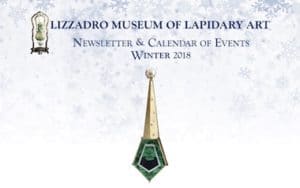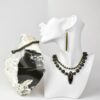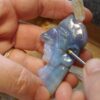Phenomenon in Gems: Remarkable optical illusions of colored gemstones
By Sakina Bharani
Phenomenon in gems displays unusual optical properties. These gems are rare. The optical phenomenon depends on different ways the light beam behaves when passing through a gemstone. The light beam can take the form of scattering, reflecting, refracting, diffracting, absorbing or transmitting light. There are many examples of gemstone phenomenon. Some, simple and subtle and others quite striking. Many of these phenomenal effects can be seen in the special exhibit Smithsonian Gems. Other phenomenal gems can be seen around the Museum. Next time you visit the Museum take a look to see if you can identify the various optical effects described in this article. Listed below are some of the popular phenomena seen in gemstones.
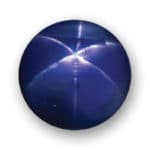
Asterism is observed in opaque gemstones where inclusions are naturally oriented in a star- like pattern with the rays of the star intersecting in the middle. There are four to six rays and rarely twelve. The inclusions are called Rutile Needles (Titanium Oxide). To appreciate the star effect properly the gem has to be cut as cabochon. Popularly called star-gems, this effect is commonly observed in Corundum (Sapphire and Ruby) and occasionally in Quartz and Diopside.
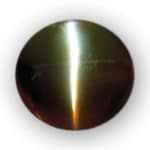
Chatoyancy: Popularly known as cat’s eye gem, (chat in French means cat). Chatoyancy refers to a phenomenon akin to opening and shutting of cat’s eye. These gems have a single sharp band (sometimes two or three bands) running across the domed cabochon surface. The Chrysoberyl cat’s eye gem is very specifically cut as cabochon to highlight chatoyancy. The rutile silk is aligned perpendicular to the crystal. So when light falls on it, the sharp band can be seen. In the best stones, the chatoyant Chrysoberyl cat’s eye visually separates the surface into two halves creating milk and honey effect as the stone is moved under light. Other gems that can show cat’s eye phenomenon are Tourmaline, Moonstone as well as Quartz.

Adularescence is named after “adularia”, (Historical name for Moonstone). The effect is due to light interference caused by layered atomic structures within the stone. The gem displays a billowy floating light which appear to come from below the surface. The term Shiller or Schiller is sometimes used to describe this effect. As in other optical phenomenon, the size and distance from layer to layer influences the colors we see. The colors can be white, blue or rainbow hues. Adularescence appears in other gemstones as well notably, Opal, Rose Quartz and Chalcedony.
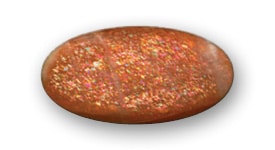
Aventurescence owes its beauty to structural features that diffract or scatter light; aventurescence is a consequence of reflection. When disk or plate like inclusions of another mineral are present which are highly reflective, they act as tiny mirrors. The gem sparkles and glitters. This glitter effect is called aventurescence. The term Shiller is also used for this glowing effect. The most common reflectors are copper, hematite and mica. The term Aventurescence is derived from the word “a ventura” meaning “by chance”. This effect is seen in Aventurine Quartz, Sunstone Feldspar and a man-made stone called Gold Stone.
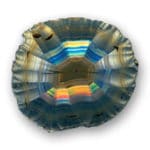
Iridescence is derived from the Greek word “iris” meaning rainbow. It is caused by diffraction of white light as it is passing through small openings such as pores and slits or when light passes through thin layers of different minerals with different refractory indices. A prism effect causes light to separate into various spectral colors. Iridescence is the most common optical phenomenon and the most mesmerizing one. It can be easily appreciated in nature such as on the neck of the pigeon, soap bubble, wings of a butterfly or iridescent beetle. Gems with remarkable iridescence are thinly sliced Iris Agate, Fire Agate and Ammolite. Coating the surface of an ordinary gem with a chemical and heating can produce man-made iridescence.
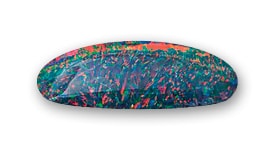
Play of Color: Iridescence in precious opal is called “Play of Color”. Opals are generally divided into precious and common, based on whether they have Play of Color or not respectively. Play of Color is seen as shifting patches of spectral colors on a gem’s surface and/or in its interior. This phenomenon is actually caused by a unique ultra structure of the Opal. The Opal is made of spheres of silica, which are arranged in closely stacked layers and have air or rarely liquid between them. These spaces with air or liquid cause diffraction and split light into various colors. Thus we get a shifting group of colors that flicker and move as we move the stone. The colors we see depend on the size and regularity of arrangements of the spheres. With larger spheres more red (more value) and with smaller spheres more blue is seen (less value). As with any gemstone, color preferences are subject to individual tastes.
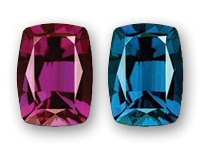
Color Change: Some gemstones appear very different in daylight (natural light) and incandescent light. This phenomenon of “color change” is typically observed in a gem called Alexandrite and this effect is also called “Alexandrite x Effect”. The Alexandrite appears green in daylight and reddish purple in incandescent light. Other gems that display color change phenomenon occasionally are Sapphire, Spinel, Garnet and Tourmaline.
References:
Gemstones of the World, Schumann, W., Sterling Publishing Co., 2013.
Gemstones Symbols of Beauty & Power, Gubelin, E., Erni, F., Geoscience Press, Inc. 1999.
Gemological Institute of America (GIA) resources. International Gem Society (IGS) resources. Photos courtesy of the Smithsonian Geogallery.
Sakina Bharani is a gemologist and Museum docent. She has presented several lectures on gemstones. Her lecture on Phenomenal Gems will be held on February 24, at 2 p.m. at the Museum. After the lecture join a guided tour of the Smithsonian Gems exhibit. Reservations are recommended.
“The Art of Jewelry Design” with Brenda Smith

Brenda Smith is an artist, metal smith and award-winning designer currently residing in Atlanta, Georgia. Her work has been exhibited in many galleries and jewelry stores, including the Forbes Gallery and Faber Gallery in NYC, the Carnegie Museum of Natural History and the Smithsonian.
A former creative director with more than 25 years of advertising, design and design teaching experience, she
easily transitioned from graphic arts to innovative jewelry design. “Jewelry design is simply another form of art and design utilizing metals and gemstones as the medium.” “I also enjoy teaching jewelry design since it is a win-win situation,” she says. “It keeps me thinking creatively in a communicative way, be it verbally or visually.”
Brenda’s work is influenced by a myriad of thoughts, symbols and unique materials. She strives to create jewelry that fuses sculptural design with powerful symbols and inspirational mes- sages. “I’m not interested in creating a variation of something that is done everyday. What’s the point? They are sculptural, and have movement and concept. My designs are inside just waiting to emerge as wearable art with a story.”
Awards and recognitions include AGTA Spectrum, Inter- national Pearl Design Competition sponsored by the Cultured Pearl Association of America, five times; Royal Asscher’s Rebel Chique Diamond Design Competition; Palladium Alliance International Design Competition, two times, the Smithsonian Museum of Natural History acquisitions, Red Carpet for the Emmys, and Oscars.
She earned her BFA in design and her BA from Kent State University and her EMBA from Kennesaw State University. She is currently a member of AGTA, CPAA, GIA, SNAG, WJA, Georgia Goldsmith Group, The Southeastern Federa- tion of Mineralogical Societies, Inc., is on the Advisory Board for the School of Visual Arts, Kennesaw State University, the Board of Directors for the Acworth Cultural Arts Center and on the board of Healing for the Nations.
Artist Statement
Brenda Smith’s jewelry is a culmination of her life experiences to date. Travel, education and experiences have all contrib- uted in molding the thought and creative processes, revealing themselves in the positive, conceptual, miniature sculptures that she creates in noble metals and gemstones to adorn others who connect with her esthetic. These timeless treasures may originate with a thought, word, experience, gemstone, shape, or a doodle. “Designing jewelry, for me, is a release of beautiful concepts and shapes that can be captured forever in this timeless medium. It is my passion. I can’t imagine doing anything else.”
Brenda Smith has two pieces on display in the Smithsonian Gems exhibit and will present “The Art of Jewelry Design” at the Museum on March 10, at 2 p.m.
Reservations are recommended.

